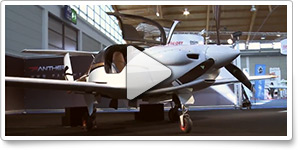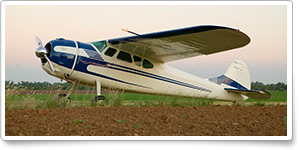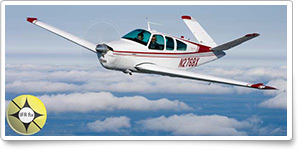| ||||||
| Guides for glides |
| |||||
Training TipsGuides for glides Not true glider time—but how frequently have you drilled on engine-out scenarios during your recent powered-aircraft training flights? If you were taken by surprise and had to struggle to remember procedures the last time your instructor idled the power and declared an engine “failure,” get some more practice soon. Focus on developing a continuing awareness of how you would proceed during each phase of flight. If it's going to be a few days or weeks before you have another lesson, take the Air Safety Institute quiz on emergency procedures. Would your altitude give you time to turn back to the airport? Is there time to attempt to restart your engine, or would it be a better call to concentrate on a safe off-airport landing? In cruise flight, keep tabs on possible emergency landing spots you pass. Estimate their distance off your course line, and accept or discard them based on your altitude, wind direction, and your experience with your aircraft's glide characteristics. Staying aware of approximate surface wind speed and direction along a route could pay big dividends in the event of an engine failure. Observe water surfaces, trees, and smokestacks for clues. Monitor weather-reporting stations along the way. That landing site down below looks usable—so now inspect the approach path for obstructions. Look carefully for hidden traps like a low fence or hedge row near your chosen touchdown spot. Arriving at a cross-country destination, it's comforting to know that you have the runway “made” after descent to traffic pattern altitude. Don't drift out of glide range by flying too wide a pattern, or by allowing yourself to get too low on final approach. Too high on final? A forward slip can help you lose altitude before you are ready to commit to using flaps. Clearing the engine is essential during sustained periods of power-off flight such as a simulated engine failure glide to a landing site (or to a minimum safe altitude when practicing off-airport). Make your practice safer by recognizing likely conditions for the formation of carburetor ice—common this time of year in many areas. You may be able to recite your aircraft's emergency procedures checklists from memory when sitting at home in your favorite armchair. Regular practice using them assures that you can make them flow as advertised when it counts. Flight Training NewsFlight hours up, accidents down in 2010Fixed-wing aircraft and helicopters flew more hours and had fewer accidents in 2010, yielding lower noncommercial accident rates, according to a preliminary report issued May 1 by the Air Safety Institute. The accident rates of commercial GA flights—charter, crop-dusting, and external load operations conducted for pay—maintained the improvements seen over the past five years. Read more >> Tennessee pilot wins Sporty’s sweepstakes SkycatcherU.S. Army Reserve Lt. Col. Matthew Smolin of Germantown, Tenn., answered what he may have thought was a prank call on May 19. But the call from Sporty’s President Michael Wolf was legit: Smolin had won Sporty’s 2012 Sweepstakes Cessna Skycatcher. The winner was announced at Sporty’s annual fly-in at Clermont County Airport in Batavia, Ohio. Read more >> FAA modifies rule on Class D taxiing operationsA general aviation pilot based at a small airstrip faces many challenges when using larger, more complex airports. Under past practice, a ground clearance listing a series of taxi instructions—with no mention of runways crossed—might have been one of them. To cross, or not to cross? That was a question to ponder. Read more >> Strong launch sustains pilot club 50 years laterThe Elkins Pilots Club started with a bang 50 years ago with one instructor, one Piper J-3 Cub, 27 solos, and more than 100 students in its first 12 months. The club recently celebrated its golden anniversary, and the Cub that started it all was front and center at the event. Read more >> Here comes the sunThe sun rises. The sun sets. And occasionally it spews forth extra energy—sometimes, a lot of extra energy. Should pilots be concerned? Reports of increased solar activity are starting to occur more frequently, and these geomagnetic storm, solar flare, and coronal mass ejection events are collectively known as “space weather.” But what do these terms mean and why are they important? Listen to scientist Joe Kunches from the NOAA Space Weather Prediction Center in Boulder, Colo., talk about space weather and its impact, if any, on general aviation. Watch AOPA Live® >> Training ResourcesWhich flight school is right for you? Before we can help you find the perfect fit, you'll need to know your ultimate long-term aviation goal. Is it a flying career? Do you want to fly for fun? The answer will affect your decision-making process. Read tips on choosing a flight school from the Flight Training website, and use our online flight school directory to further assist you.
Did you know that student pilots who join AOPA are three times more likely to complete their flight training? Membership includes unlimited access to aviation information by phone (800/USA-AOPA, weekdays from 8:30 a.m. to 6 p.m. Eastern time) or from Flight Training Online or AOPA Online. If you’re not already a member, join today and get the pilot’s edge. Login information is available online. Pipistrel Panthera Career PilotNew routes to Washington National announcedSeveral carriers have been awarded new routes to Ronald Reagan Washington National Airport. The new service was made possible by enactment of the FAA Modernization and Reform Act of 2012, which authorized the Department of Transportation to award a limited number of new flights to U.S. domestic airports located beyond the airport’s 1,250-mile “perimeter limit.” United Airlines announced May 14 that it will begin service between Ronald Reagan Washington National and San Francisco International Airport. Virgin America also will begin service between DCA and San Francisco International. JetBlue was granted a beyond-perimeter slot exemption to fly between DCA and San Juan’s Luis Munoz Marin Airport. Finally, Alaska Airlines will offer a daily nonstop flight between DCA and Portland, Ore., with service beginning by Sept. 8. Embraer delivers 300th PhenomBrazilian aircraft manufacturer Embraer recently announced the delivery of its 300th Phenom business jet. The Phenom 100 and 300 business jets are powered by Pratt & Whitney Canada PW617F-E and PW535E engines, respectively. “The success of the Embraer Phenom family of aircraft is a testament to the aircraft’s appeal in this segment of the business jet market,” said David Van der Wee, vice president of marketing for Pratt & Whitney Canada. The PW500 family has accumulated more than 9 million flight hours, and has a basic overhaul interval of 5,000 hours. The approximately 2,000 PW600 engines in service have accumulated more than 1 million flight hours. Plane SpotterCessna 190/195: Classic five-seater Training ProductsPrivate pilot online ground school from ASAWhether you prefer to study via your computer, tablet, or smartphone, you can complete your ground school training with the ASA Private Pilot Ground School from Aviation Supplies & Academics. The curriculum includes nearly 11 hours of video instruction and enables you to take practice tests and obtain the FAA knowledge test endorsement via any Internet-connected device. The $179.95 fee gives you access to the course for 24 months after registration and includes a notebook that you can use to take notes, journal, or organize your studies. Order online. Note: Products listed have not been evaluated by ePilot editors unless otherwise noted. AOPA assumes no responsibility for products or services listed or for claims or actions by manufacturers or vendors. Member BenefitsAOPA Aviation Summit brings all-new learning experiencesAOPA is bringing more than 100 hours of education to AOPA Aviation Summit in Palm Springs, Calif., Oct. 11 through 13. You’ll connect with experts and new tools that will help you retain and recall critical information when you need it the most. Topics include making better landings; passing your checkride; choosing a CFI; and more. Read more >> When it comes to your health, think like a pilotPilots strive to minimize risk before flights, so why do some think and act differently when it comes to their health? AOPA Director of Medical Certification Services Gary Crump shares information on screening tools to facilitate early detection of colorectal and colon cancer. Read more >> BlogsWhat I miss about GAWould it surprise you to learn that professional pilot Chip Wright would change places with a general aviation pilot in a heartbeat? Also in this week’s Flight Training blog, Wright invites you to answer a job interview question about alcohol and flying. New experiences: A power pilot chases a glider ratingSteve Tupper finds that flight in a motorglider offers a new and exciting way to add a rating while sharpening flying skills. Read more in the Let’s Go Flying blog. AOPA Career OpportunitiesEver dream of turning your passion for aviation into a career? We’re looking for a vice president of information systems; registration, housing, and meeting planner; aviation technical writer; member services representative; project manager of online products; and associate editor–Web/ ePilot. To learn more about other AOPA career opportunities, visit AOPA Online. Community
AVIATION EVENTS & WEATHER
| ||||||||||||||||||||||||||||||||||||




 Have you logged any gliding time lately?
Have you logged any gliding time lately?





